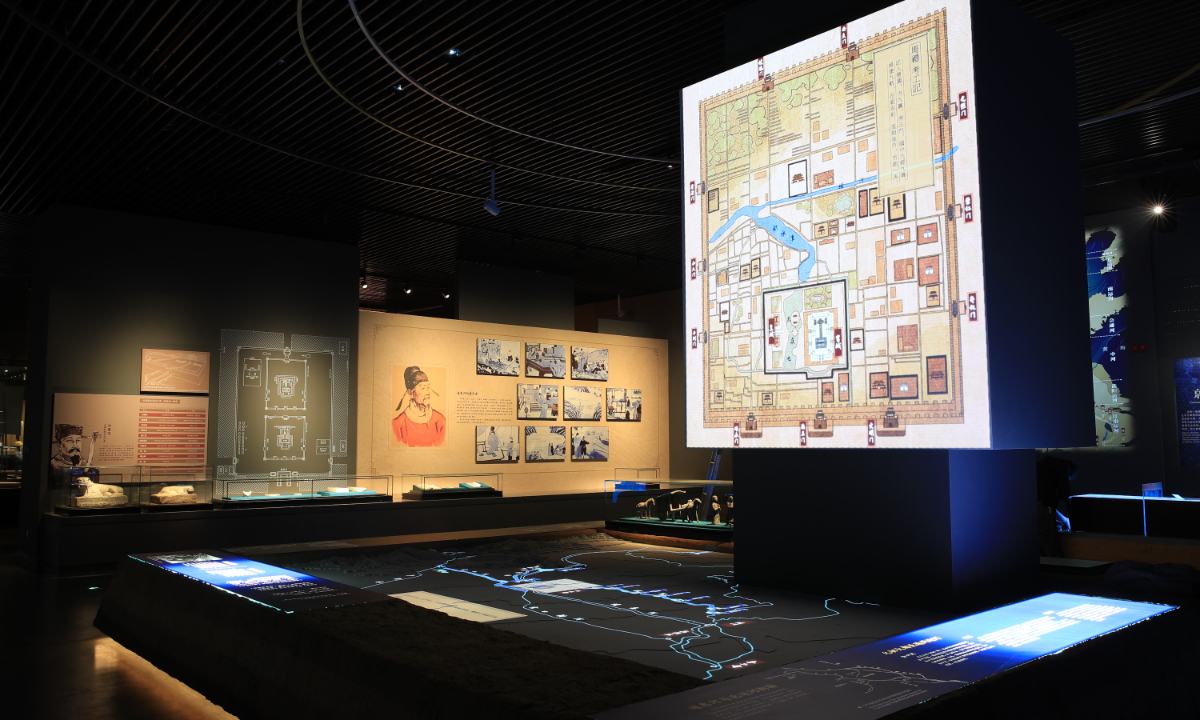
The Grand Canal Museum of Beijing is opened on December 27, 2023. Located in Tongzhou, a burgeoning sub-center in the eastern district of Beijing, it has at least 1,000 pieces of centuries-old precious cultural relics of the UNESCO world heritage the Grand Canal collected inside the tree-story museum. Photo: Courtesy of the Grand Canal Museum of Beijing
As the Grand Canal Museum of Beijing opened on Wednesday, its 242 orange rubber mats offers strong protection for the museum's centuries-old precious cultural relics.
The Museum is located in Tongzhou, a burgeoning sub-center in the eastern district of Beijing, which has at least 1,000 pieces of centuries-old precious cultural relics of the UNESCO world heritage the Grand Canal are collected inside the enormous museum resembling an ancient sailboat.
Together with a concurrently unveiled art center and a library nearby, these three architectural marvels are set to become landmarks in eastern Beijing, facilitating functions in the capital.
The secret of the three-story canal museum lies in these hundreds of seismic isolators concealed beneath the venue.
From the seismic exhibition area on the underground floor, through the transparent glass, one can visualize the colossal seismic isolators crafted from rubber and other materials. These isolators are designed to minimize potential damage during earthquakes by absorbing seismic longitudinal and transverse waves.
During the recent earthquake in Northwest China's Gansu Province, numerous centennial artifacts including grottoes, pottery and jade, suffered nearly irreparable damage. The newly inaugurated Grand Canal Museum of Beijing has taken note of this concern.
"At the inception of construction, considering the impact of the subway beneath the museum, we endeavored to minimize vibrations and potential harm to artifacts. We have implemented extensive seismic protection measures, achieving an overall reduction of 60 percent to 80 percent in seismic waves," said Zhao Yazhuo, the new museum's exhibition department curator, in a statement to the Global Times.
Simultaneously, display cases housing precious artifacts have also employed seismic-resistant technology, striving to maximize protection against the ravages of disasters on these centuries-old treasures.
China's Grand Canal has stood for around 2,500 years, and is one of the world's longest and oldest artificial waterways. Stretching 1,794 kilometers from Beijing through Tianjin, Hebei, Shandong, Jiangsu, to East China's Zhejiang Province, this ancient marvel has shaped the landscape and history of China.
"Due to geographical factors, China's water systems are primarily distributed east to west. The emergence of the Grand Canal, however, links five major water systems—Haihe River, Yellow River, Huaihe River, Yangtze River, and Qiantang River—providing significant value for navigation, irrigation, and drainage. It has served as a vital artery for transport throughout different dynasties, playing a crucial role in the cultural and economic exchange between the north and south," explained Huang Jie, executive vice-dean of Yangzhou University's Grand Canal Research Institute, to the Global Times.
Established during the Spring and Autumn Period (770BC-476BC), shaped during the Sui Dynasty (581-618), and flourishing in the Tang (618-907) and Song (960-1279) dynasties, the Grand Canal symbolizes a cornerstone of ancient Chinese civilization. Today, the Beijing-Hangzhou Grand Canal plays a pivotal role in supporting China's South-to-North Water Diversion Project, serving as a golden ally in addressing water scarcity in northern cities.
However, for many enthusiasts and even scholars fascinated by the Grand Canal, presenting this millennium-old history is no easy feat.
Located in the northwest corner of the Green Heart Forest Park, the new museum, started construction in October 2019, consisting of four areas including basic exhibition, thematic exhibition, temporary exhibition and open exhibition.
With the aim of being enchanting and captivating, the newly inaugurated Grand Canal Museum of Beijing has unveiled an immersive canal experience center within one of its exhibiting halls. Visitors can now step back in time and immerse themselves in the rich history of the construction of the Grand Canal, experiencing the cultural vibes along its banks from past centuries.
As the east branch of the Capital Museum in Beijing, the Beijing Grand Canal Museum has transported a portion of relevant collections from the main museum to its new location. "In addition to items donated by individuals, we've collaborated with over 30 museums outside Beijing to borrow artifacts for display," revealed Tan Xiaoling, deputy director of the Capital Museum, to the Global Times.
To captivate a younger audience and present the history of the Grand Canal in the most engaging manner possible, the museum has maximized its openness to various branches such as cultural and creative enterprises and gastronomy.
Even after the museum doors close, these innovative cultural stores, book stores and quirky cafés tend to remain open to the public. "Alongside showcasing artifacts, we aim to make this a gathering spot for the younger generation. That's why the subway station downstairs directly connects to our gourmet zone, where we offer dozens of Beijing's intangible cultural heritage cuisines," shared Zhang You, director of the museum's preparatory department, with the Global Times.